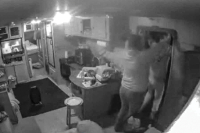Macon steep-slope ordinance inches forward
Macon County’s commissioners want their planning board, if possible, to finish up work on a steep-slope ordinance by August.
Commissioner Bobby Kuppers last week also asked planning board members not to give up on the proposed ordinance, but to see it through as commissioners had requested.
“Let’s finish the conversation,” Kuppers, who serves as the county commissioner liaison to the planning board, urged members.
This after what Planning Board Chairman Lewis Penland wearily described as a long few weeks, in which members have drawn the ire and criticism of local anti-planning advocates. Coupled with less than enthusiastic support of even the concept of a steep-slope ordinance from some of its own members, there have been difficult times, he said.
The steep-slope subcommittee presented its recommendations to the full planning board May 19.
“We need to finish this document,” Penland said. “If we don’t, then two years worth of work (by the subcommittee) would have been in vain.”
Related Items
The previous board of commissioners sanctioned the creation of a steep slope ordinance and even signed off on guiding principles developed by the committee. But two of the five commissioners are new to the board of commissioners since the last election, Republican Ron Haven and Republican Kevin Corbin.
Corbin said it’s too soon to speak on whether he will support a steep-slope ordinance.
“They have not presented us with anything – it’s still with the planning board, so there’s nothing to approve or disapprove at this point,” he said this week. “They’ve got to go through the process on what the planning board actually wants to present.”
Haven could not be reached for comment before press time.
During the planning board’s meeting in May, member Lamar Sprinkle said of the proposed ordinance, “as a private property owner this scares me to death.”
He added that while he felt that road standards did need to be addressed, there was simply no need to go to the level of detail contained in the proposed ordinance.
Sprinkle, a local surveyor, said he felt the recommendations would “be a detriment to development” in Macon County.
Penland urged members, including Sprinkle, to set aside for-and-against feelings and concentrate on the task at hand — a line-by-line, technical review of the recommendations.
“There’s a time and a place for the other discussions, and we’ll have those,” Penland said.
The planning board reviewed basic definitions contained in the proposed ordinance, and discussed the finer points of LiDAR (Light Detection and Ranging), a device similar to Radar that can be used for slope measurements. Members also began discussing the slope thresholds used in the proposed ordinance.
Points from Macon County’s draft ordinance
• Regulations vary, with rules becoming stricter as slopes get steeper. Certain rules would apply everywhere regardless of slope.
• The draft makes use of landslide hazard maps prepared by the N.C. Geological Survey. Areas at risk of landslides must comply with stricter parts of the ordinance even if their slope is not terribly steep.
• The proposed ordinance establishes an “influence zone” that includes both on-site and off-site land that might be influenced by land-disturbing activities. At a minimum, the influence includes the “grading envelope” plus an area defined by a line located 35 feet beyond the grading envelope.
• A design professional, typically an engineer, is only required or the steepest or potentially most hazardous sites.
• The proposed ordinance does not contain any language that precludes building on any site in Macon County, no matter how steep or potentially hazardous it may be.
Crafting a sliding scale
Basic rules would apply to every building site in the county, regardless of how steep the slope is. Those include:
• Graded or structurally stabilized slopes cannot be higher than 30 feet.
• Fill slopes must have a minimum compaction of 92 percent standard proctor density and must be benched.
More stringent measures are required on the highest risk sites. Construction sites are placed into one of four categories, three of them dependent on how steep the slope is, and one dependent on the landslide risk.
• The least steep slopes or no slope at all — less than or equal to 30 percent — are only required to comply with the general requirements. No additional action required.
• Intermediately steep sites — having slopes greater than 30 percent but less than 40 percent — may be approved by the county slope administrator as submitted if they meet certain conditions.
• The steepest sites — with slopes greater than 40 percent — require the services of a design professional such as an engineer to prepare plans, specifications and a written report for development of the site.
• Sites classified with moderate to high risk on the state landslide hazard map even though they may have minimal slopes, may be in the path of hazardous debris flows. These sites also require the services of a design professional.









